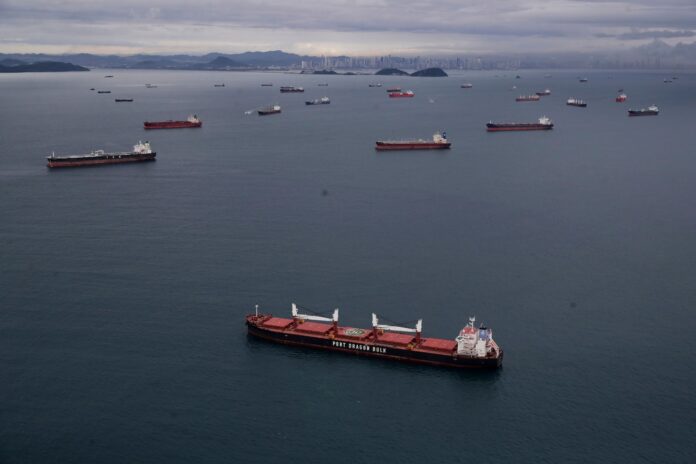And things could get worse.
“We have all the conditions we need to repeat what we had with 2015-16,” said Steven Paton, who heads the environmental monitoring program at the Smithsonian Tropical Research Institute. That was one of the driest periods on record in many areas of the Central American nation.
“There will absolutely be greater restrictions” on ships crossing the canal next spring, the driest time of the year, he said.
To conserve water, canal authorities are limiting the number of ships allowed to make the crossing to 32 per day, down from an average of 36 in normal times. They’ve also imposed weight restrictions on the vessels. Around 50 million gallons of water is required to move each ship through the locks. Only some of it is recycled.
Normally, there are up to 90 ships waiting to enter the canal; this week, there were more than 120. Earlier this month, as many as 160 ships sat idling.
The congestion is adding to the global bottlenecks caused by the Russian invasion of Ukraine and the covid-19 pandemic, said Abe Eshkenazi, CEO of the Chicago-based Association for Supply Chain Management.
“We’re seeing just another disruption on top of an already stressed system,” he said.
Panama is ordinarily considered one of the world’s wettest countries, with a rainy season that extends from May until late December. But the canal region is suffering one of its driest years since record-keeping began 143 years ago, said Paton.
This summer, high-pressure heat domes have focused on much of the Caribbean and Central America, squashing rainfall chances and delivering intense heat. Mexico and other countries in the region are also dealing with widespread drought.
In addition to the lesser replenishment of the lakes that feed the Panama Canal from the source rainforests, the hot and dry conditions lead to higher water temperatures and increased evaporation. This means even less available water in the lakes, and lower waters in the canal itself.
A combination of a developing and powerful El Niño, the warming of waters in the equatorial Pacific Ocean, and human-caused climate change are probably supersizing Panama’s recent dry spell. While El Niño acts as a multiplier, the drought was underway earlier in the year – February through April featured about 10 to 25 percent of normal rainfall in the area.
“The main impacts of climate change in Panama are related to the increase in the number, intensity and variability of extreme precipitation events, severe droughts and high temperatures,” said the United Nations’ Piedad Martin earlier this year when the Panama government launched a program to increase climate resilience.
Gatun Lake, which forms a significant part of the 50-mile Panama Canal route and provides water to move ships through the locks, is now about three feet below normal. The level will start to fall quickly once the dry season begins in December, Paton said.
Canal authorities have cut the depth limit for large vessels from 50 feet to 43.5 feet so they’ll avoid scraping the lake bottom. That has forced some ships to offload containers onto trains and pick them up on the other side of the passageway, adding to transportation costs.
The traffic pileup is affecting everything from tankers carrying liquefied natural gas to vessels piled high with containers of toys and auto parts.
Eshkenazi said there are few attractive options for manufacturers trying to avoid the traffic jam. Sending ships around the southern tip of South America or through the Suez Canal would add cost and distance to their trips.
Many U.S. firms have started to near-shore their production to countries such as Mexico, but those are long-term investments. Shifting production from China will “require significantly more truckers and significantly more warehouse space than we have today,” Eshkenazi said.
Mexico’s president, Andrés Manuel López Obrador, said this week that one of his ambitious infrastructure projects — a 180-mile train line across the Isthmus of Tehuantepec to connect Atlantic and Pacific ports — could be an “alternative” to the canal. But the train line is still under construction.
The Panama Canal — started by France, finished by the United States and opened in 1914 — was considered one of the world’s great engineering marvels. It was controlled by the United States until 1999, when it was handed over to Panama. A $5 billion expansion completed in 2016 doubled its cargo capacity.
The canal has turned Panama into a logistics and trade hub. The nation of 4 million people has the highest income per capita in Latin America, according to the International Monetary Fund.
The canal’s administrator, Ricaurte Vásquez, said this month that the weather-related problems could cause a drop in fee income of up to $200 million next year. The canal had initially projected collecting $4.9 billion.
Canal authorities have worried for years about the risks of a warming planet.
“We knew climate change was going to have an impact. We should not be surprised,” Eshkenazi said. “Now the question is, what do we do about it?”
Ian Livingston in Washington contributed to this report.



